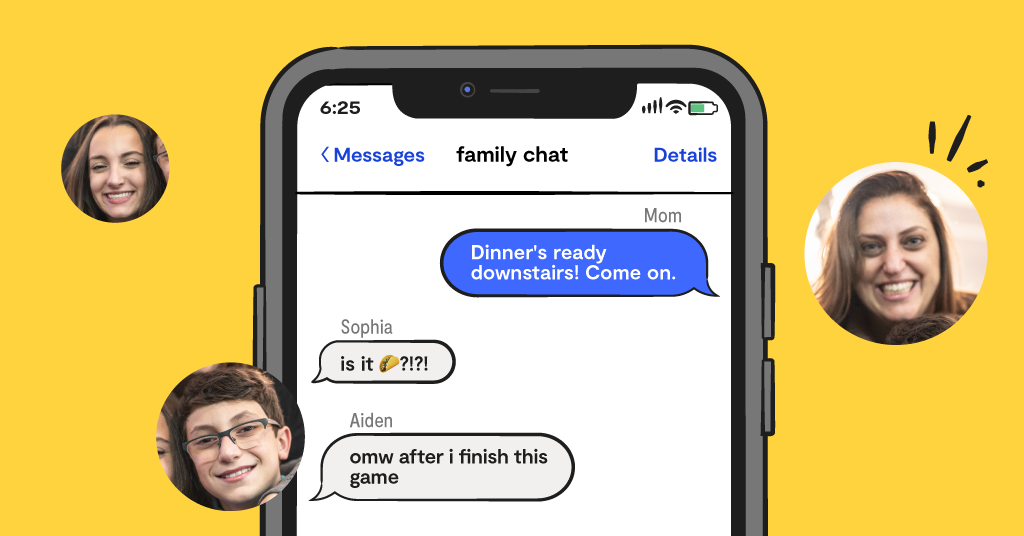Why call your kid down for dinner when you can just text them from the next room? In today’s homes, it’s not unusual for families to communicate more through screens than face to face, even when they’re just a hallway apart.
This shift in tech and communication isn’t necessarily a bad thing. Texts, voice notes and DMs are all part of the way today’s kids build relationships and manage emotions. A study published in Pediatrics found that screen-based communication now plays a central role in how kids stay connected with both friends and family. But as family screen time rises, so do new patterns in digital family dynamics, from how we check in during the day to how we argue at night.
So, how exactly is tech changing family dynamics? And how can you model healthy communication across the digital divide? Below, we break it down.
How Digital Communication Is Reshaping Family Life
Texting keeps you close but tone can be challenging
Texting can make parents feel closer to their kids throughout the day (“Need a ride?” “Good luck on your test!”). But tone doesn’t always come through clearly, which can create confusion or even conflict. A “K” from a teen can sound angry even when it’s not, and sarcasm often gets lost without context. And don’t even think about ending a text with a period!
Strengthening sibling relationships
Siblings now bond over Instagram memes and TikToks more than movie nights. This shared digital humor strengthens connection but can also fuel misunderstandings, especially when disagreements play out in the group chat for everyone to see.
Complicating family arguments
Heated discussions are no longer reserved for the dinner table. Families are increasingly engaging in conflict over text, which can drag out misunderstandings without the benefit of body language, immediate feedback or resolution cues. What starts as a disagreement can turn into a silent standoff with read receipts.
Why kids prefer digital communication
For teens, texting often feels easier and safer than talking in person. It gives them time to think about what they want to say and a little emotional space if the topic is difficult. That’s especially valuable during adolescence, when emotions can feel really overwhelming.
What’s more, digital messaging often feels physically more comfortable. There’s no eye contact to navigate, no facial expressions to decode and fewer chances of saying the wrong thing in the heat of the moment.
The role of emojis, voice notes, and DMs
While parents may still favor phone calls or face-to-face conversations, kids today are fluent in emotional shorthand. Linguist Vyvyan Evans, author of The Emoji Code, describes emojis as the “digital body language” of modern communication — adding tone, context, and emotion to otherwise flat messages. A single emoji can sometimes convey more than a wall of text and often feels more personal than a standard reply. They also add a touch of levity to messages that might come across as more serious than planned.
Voice notes are also gaining popularity, serving as a low-pressure middle ground between texting and calling. They’re quick, personal, and allow for more nuance without the intensity of a live conversation.
Direct messages (DMs) on platforms like Instagram or Snapchat offer another way teens connect. Often shared alongside memes or trending videos, DMs let kids react, relate, and plug into the larger cultural conversation.
How to Model Healthy Communication On and Offline
Modeling healthy habits is one of the most powerful ways to teach kids how to navigate digital communication with confidence, clarity and care. It’s less about strict controls and more about setting an everyday example they can follow. Here’s how to start:
Mix it up
Use different communication styles for different needs. A quick “Need anything?” text is great for small stuff, but emotional check-ins or conversations about boundaries are better face-to-face.
Talk about tone
Without body language or facial cues, digital messages can easily be misread. Help your child recognize when tone may be unclear and how to ask for clarification before jumping to conclusions.
Lead by example
Kids learn how to communicate by watching you. Model what respectful conflict resolution looks like, whether you’re texting a coworker or resolving a disagreement over dinner.
Set digital boundaries
Create screen-free zones or times, like during meals or bedtime routines. These quiet moments help preserve space for real connection and teach kids the value of being present.
How Bark Can Help
Tech isn’t ruining communication. It’s just changing how we connect. By staying curious, modeling healthy digital habits and knowing when to unplug, families can build stronger and more intentional relationships both online and off.
Still, keeping up with every app, message and screen limit can feel overwhelming. That’s where Bark comes in. With tools for screen time management, content monitoring and real-time alerts, Bark helps you stay informed without hovering. Explore Bark’s tools to find what works best for your family.
Read more
Bark helps families manage and protect their children’s digital lives.






